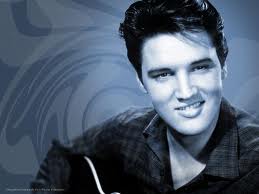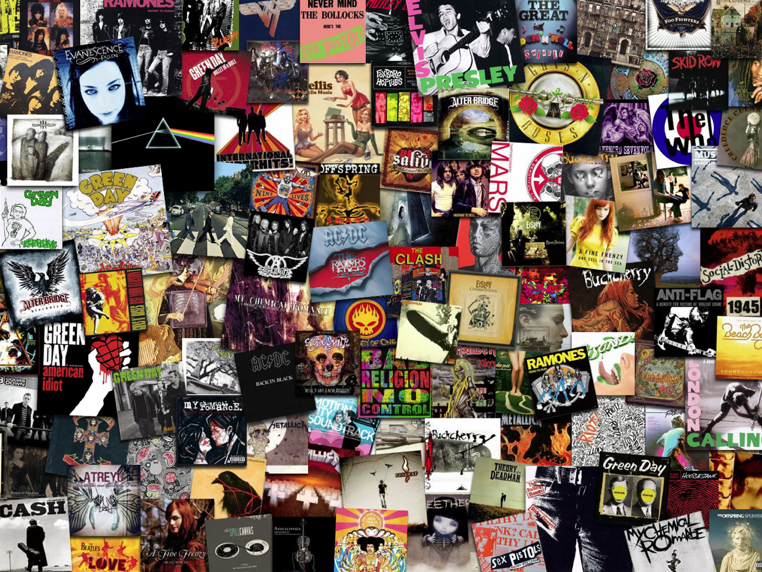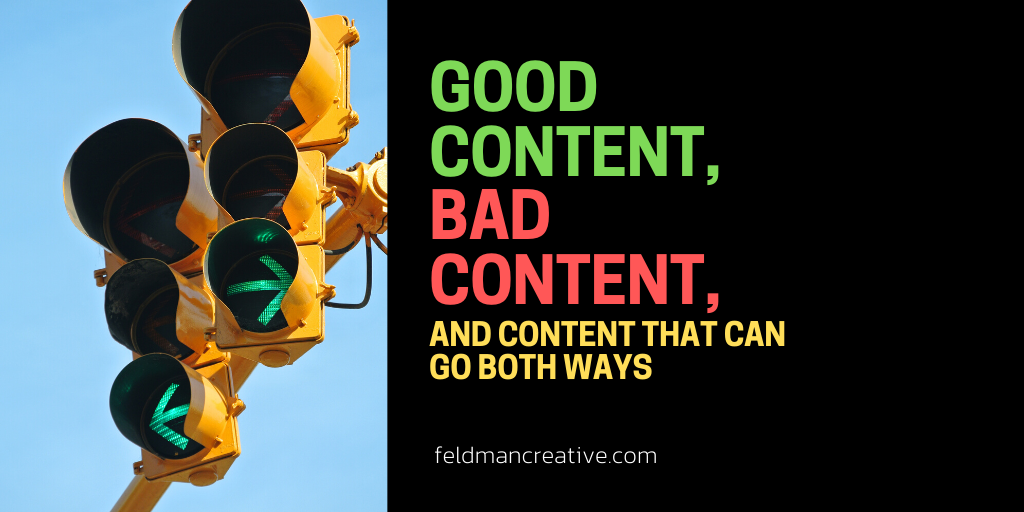Face it content marketers, it gets harder every day to get noticed. Everyone is strumming away at this content marketing thing, but a sea of sameness prevails. Very few have truly unique tunes, so it gets perpetually harder to get people to … well … tune in.
 Allow me to take you back in time — starting in the mid-50s and then moving on through the decades that followed — to examine 11 legends of rock and roll.
Allow me to take you back in time — starting in the mid-50s and then moving on through the decades that followed — to examine 11 legends of rock and roll.
Why, you ask?
Each epic act I’ll introduce built a timeless brand based on a signature style. And I believe, from these rock icons, you’ll be able to extract insights and ideas for creating bigger hits with your blog posts, ebooks, videos — pretty much any kind of content.
So, are you ready to rock?
Here’s a version of this story as a SlideShare.
The story starts in Memphis.
There was this kid from Tupelo, Miss. who came to Memphis to get a recording contract. The magic didn’t happen instantly.
In 1954, the young crooner, named Elvis Presley, was given the chance to audition at Sun Records. The label’s owner, Sam Phillips, was looking for a new and fresh sound. He later admitted he wanted a white boy who sounded like a black bluesman.
Elvis nearly blew it. He sang a Bing Crosby hit and a country standard. Phillips wasn’t hearing what he hoped to. He suggested Elvis and his backing band take a break. During that break, Elvis picked up a guitar and began belting out an unconventional take on a blues tune called “That’s Alright Mama.”
Phillips was transfixed. He asked Elvis, “What are you doing?” The reply: “We don’t know.” Sam told them to do it again. He rolled tape. Elvis sang frenetically. His inflections were odd — but compelling. He shook his hips and danced with abandon. He sneered.
They made a record together, and rock and roll was born.
What happened? Musical forms collided. Country got the blues. The result was a crazy new sound.
In the years that followed, Elvis reeled off an amazing string of hits. One of them was “All Shook Up.” The song title describes his legacy. Elvis shook up the music industry.
Can you create content that shakes things up? I suggest you try.
Along comes the rock and roll band.
A number of great acts cut from the Elvis cloth populated the airwaves in the late 50s. Carl Perkins. Jerry Lee Lewis. Chuck Berry. Gene Vincent. Eddie Cochran. Notice the pattern? All were known by a man’s name.
Buddy Holly broke the mold a bit by assembling The Crickets. As the lead singer, guitar player, and songwriter, it was clear The Crickets was Buddy’s band.
A kid from Liverpool was hypnotized by The Crickets. He was obsessed with the idea of forming a band. He envisioned multiple personalities and players melding their voices to create a different kind of sound. His name, of course, was John Lennon — arguably the most influential musician who ever lived.
Lennon was introduced to a lad named Paul McCartney — an even stronger musician who was a natural. Paul blew John’s mind. Paul knew a youngster named George who could make the guitar gently weep. The trio hired and fired a drummer then recruited a local hotshot nicknamed Ringo.
John insisted the rock and roll outfit’s name would pay homage to The Crickets, so they chose another bug — beetles. Then they replaced an “e” with an “a.” Then they produced records, radio shows, and movies that created a new chapter in popular music — one that beats as strong now as it did then.
With The Beatles, no single personality dominated. They blended their voices, personalities, and styles. They innovated endlessly. They goofed off tirelessly.
The Beatles created a magical mystery tour through the power of collaboration and teamwork.
Can you do the same? Can you “Come Together?” How might you bring a band approach to your content marketing efforts?
Paint it black.
“I was keen on Chuck Berry, and I thought I was the only fan for miles,” wrote Keith Richards. But one day, a bloke named Mick came up to Keith at a train station and told him he too loved Chuck Berry as well as American bluesmen such as B.B. King, Howlin’ Wolf, and Muddy Waters.
Keith discovered Mick could sing. Mick discovered Keith could play. They created a band and named it The Rolling Stones — after a Muddy Waters record. They collaborated much like The Beatles, but they created a very different brand of rock and roll.
The Stones explored the darkness. They painted it black. Couldn’t get no satisfaction. They had sympathy for the devil.
No band before them was as brash or dangerous. When most music was romantic and clean, The Stones got rougher, tougher, down, and dirty.
What if you were to draw from a darker place? You could play devil’s advocate with your content. Instead of offering how-to content and success stories, what if you focused on dangers, mistakes, and failures?
The Rolling Stones challenged status quo. Try doing the same.
The times they were a-changin’.
Bob Dylan changed popular music forever.
A self-taught guitarist and harmonica player, Dylan was inspired by the folk singers of a previous generation — Woody Guthrie and Hank Williams, in particular.
Acoustic guitar in hand, Dylan moved to New York City and played the clubs and coffee houses of Greenwich Village. His act was more lyrical than any that preceded it. Dylan composed songs with a narrative voice. He was introspective. His themes were boundless.
Bob Dylan inspired people to pay attention to what was going on. He never backed down or gave in. Dylan wrote protest songs.
What if you did the same? What if your content was as fearless as Bob Dylan’s? Readers love the truth. “The order is rapidly fading,” wrote Dylan.
Are you bold enough to tell it like it is?
See me, feel me, touch me.
The Who created rock opera. The band’s greatest works were rich epics with characters and conflict. The literate writing of the band’s main songwriter and leader, Pete Townshend, was highly reflective of the human condition.
The Who’s most noted masterpiece was “Tommy,” the story of a deaf, dumb, and blind pinball wizard who unknowingly became a messiah to lost souls.
Tommy is a crazy story. People tune into crazy stories. And great stories are at the heart of memorable content.
How might you tell a great story?
Dazed and confused.
Very few bands left an imprint on rock and roll to the degree Led Zeppelin did.
Zeppelin’s massive, guitar-driven sound introduced a new brand of rock. Led Zeppelin took a conventional form of music, the blues, and added all kinds of new layers. Mysticism. Volume. Pounding beats. Rock and roll got heavy — and metal — when Zeppelin blasted its distorted and intense version of the blues.
Twist convention, and your content might rock harder and louder. Don’t be afraid to turn it up.
Another brick in the wall.
Pink Floyd turned the rock and roll experience into theater.
Like The Who, Pink Floyd evolved into masters of the concept album. Its records didn’t necessarily tell stories, but featured connective tissue — that is, themes. Insanity became a recurring theme. “Dark Side of the Moon” is the best example of this (and one of the reasons why it set and still owns the record for the longest-charting album ever made).
In the band’s most noted and memorable works, Pink Floyd went way beyond the concept album. The band featured sound effects. In concert, giant pigs flew around the arena. Laser shows synched to the performance. Walls were erected — and knocked down.
You didn’t just listen to Pink Floyd — you experienced them.
Can you create content bigger than merely words? How might you create theater?
A runaway American dream.
Springsteen gave us glory days (though this is far from a past tense).
Examine the records Bruce has made. The truth is, they have little in common. Like most epic artists, he chooses not to repeat himself. However, his stories (make no mistake, Springsteen songs are stories) always star the common man. He highlights our triumphs and our failures.
“It’s a town full of losers, and I’m pulling out of here to win.”
Bruce writes about our passions and pains. If you’re paying attention, you feel them. He writes about the human condition and its highs and lows.
Can you give your content a voice? How can you make it real? Can you tap into universal human emotions?
Anger can be power.
My favorite The Clash song, “Clampdown,” declares, “Let fury have the hour. Anger can be power.” Now that, my friends, rocks.
The Clash produced “revolution rock.” It came to be known as a brand called punk. The music and lyrics were charged with righteousness. The Clash was a group of outspoken, outrageous outlaws — ones with guitars. The band rallied for the working class. It ranted against the right. And it rocked with unrelenting rebellion.
When you create content and want people to hear you, speak your mind.
‘Cause this is thriller.
The king of pop, Michael Jackson, is one the most popular recording artists ever — and for plenty of reasons.
Did he have a message? Sort of. He preached peace and love, but too many artists beat him to the punch to make it his signature.
Michael’s real signature was showmanship. It became a common thread in his relentless string of mega-hits that didn’t just dominate radio, but TV too. Jackson’s stunning dance skills and elaborate videos inspired the whole world to tune into a rising media star called MTV.
If you want to take a cue from MJ, shine bright on-screen. Can you say “YouTube?”
Touched for the very first time.
Madonna defined vogue. Perhaps she even created it. Critics say she was probably the first female pop music phenom to control her brand in every way.
Love her or not, Madonna does it her way — which is sexual. She created a seductive image. It worked. Its appeal was undeniable. And then she recreated it over, and over, and over again in new and interesting ways.
She commanded the media with her energetic dance music and unabashed sexuality. How many imitators does Madonna have? In my opinion, she is the most emulated musical icon the world has ever known. If you want to challenge me on that, I challenge you to survey the charts and discover how many artists take cues from Madonna.
And from one content creator to another, I ask you this? How might you “express yourself?”
For those about to rock …
If you know the AC/DC song I’ve referenced, you know the phrase finishes with, “We salute you.” I wrote this article because I want you to be saluted for one thing or another.
Clearly, in choosing 11 epic rock stars, I’ve left out 11 million more. Your heroes might be Queen, Metallica, Nirvana … it doesn’t matter (though it makes for fun conversation).
My point is this: The history of rock and roll is now a 60-year study in branding. Your challenge is to create a brand, establish a voice, and own a signature style worthy of conversation.
I love rock and roll. Want an audience to put another dime in the jukebox, baby? Give them a rocking reason.
Bonus: Think like a rolling stone.
It’s official: This interactive video from Bob Dylan ranks among the most rock and roll pieces of content ever created.
Read the story on Fast Company about how at the age of 72, Bob Dylan is still shaking things up. When you watch and “play with” the video, think about how many of the lessons here have been applied in this landmark piece of work.
How do you make your content rock? Share your ideas in the comments below.







Comments
Doug Kessler
“When I met Elvis, he had a million dollars worth of talent.
Now he has a million dollars.”
The power of content distribution.
— Colonel Tom Parker
Barry Feldman
… and a very full medicine cabinet.